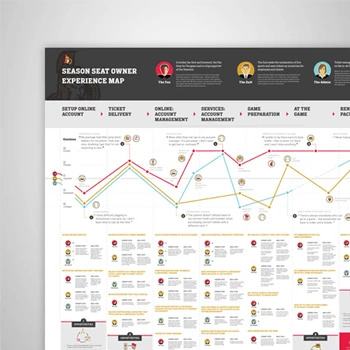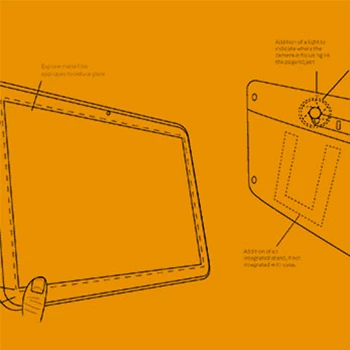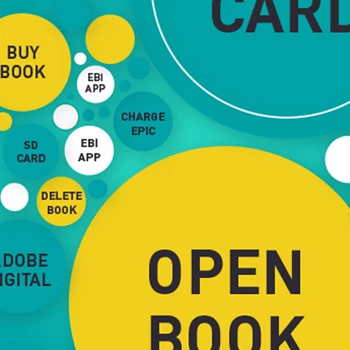What exactly is service concept design and how does it differ from product design?
Service concept design creates new service delivery models that customers desire, focusing on multi-touchpoint experiences and customer journeys. Unlike product design which centers on tangible items, service concept design addresses the complete ecosystem of interactions, processes, and experiences. Our Experience Thinking framework ensures concepts align across brand perception, content delivery, product integration, and service operations.
Tip: Consider service concept design when your offering involves multiple customer interactions, subscription models, or when the experience itself is the primary value proposition.
Why should we invest in service concept design instead of just improving our existing services?
Service concept design helps you discover how to meet evolving customer expectations who increasingly want to consume products as services and purchase on subscription bases. Rather than incremental improvements, concept design explores fundamentally new service delivery models that can create competitive differentiation and new revenue streams.
Tip: Evaluate whether your current service model aligns with how customers actually want to engage with your offerings rather than how you've traditionally delivered them.
What types of organizations benefit most from service concept design?
Organizations transitioning from product-centric to service-centric models, companies exploring subscription or recurring service offerings, and businesses facing disruption from service-based competitors gain the most value. Through Experience Thinking analysis, we identify where service concepts can strengthen brand positioning and create new customer relationship models.
Tip: Consider service concept design if customers are asking for more flexible, ongoing relationships with your organization rather than one-time transactions.
How does service concept design connect to our overall business strategy?
Service concept design directly impacts revenue models, customer lifetime value, and competitive positioning. The Experience Thinking approach ensures new service concepts align with brand strategy while opening new market opportunities. Concepts are designed to support business objectives through enhanced customer relationships and operational efficiency.
Tip: Align service concept design with strategic initiatives around customer retention, market expansion, or operational transformation for maximum business impact.
What's the relationship between service concept design and digital transformation?
Service concept design often drives digital transformation by identifying how technology can enable new service delivery models. Experience Thinking integration ensures digital capabilities support human-centered service experiences rather than technology driving service design. Concepts bridge physical and digital touchpoints seamlessly.
Tip: Use service concept design to define what transformation should achieve for customers before determining which technologies to implement.
How do you approach service concept design for complex B2B services?
B2B service concepts require understanding multiple stakeholders, decision-making processes, and integration requirements. We use Experience Thinking to map how concepts serve different user roles while supporting business objectives. Participatory design sessions include representatives from all stakeholder groups affected by the service.
Tip: Identify all the different people who will interact with your B2B service concept, not just the primary decision-makers, to ensure concepts work for actual users.
What makes a service concept innovative versus just different?
Innovative service concepts solve unmet customer needs or create entirely new value propositions, while different concepts merely vary existing approaches. Foresight design principles help us anticipate how customer expectations will evolve, ensuring concepts remain relevant as markets change. Innovation comes from understanding fundamental customer motivations, not just preferences.
Tip: Focus on the jobs customers are trying to accomplish rather than features they say they want to discover truly innovative service concept opportunities.
What does the co-design process involve and who should participate?
Co-design brings stakeholders directly into the concept creation process through interactive workshops and collaborative sessions. Participants typically include internal stakeholders from different functions, customer representatives, and subject matter experts. The Experience Thinking approach ensures diverse perspectives shape concepts across brand, content, product, and service dimensions.
Tip: Include frontline staff who interact with customers daily in co-design sessions as they understand practical implementation challenges and customer pain points firsthand.
How do you facilitate productive co-design sessions with diverse stakeholders?
We use structured facilitation techniques including scenario development, affinity mapping, rapid prototyping, and prioritization exercises. Experience Thinking frameworks help participants understand how their contributions impact the complete service ecosystem. Clear objectives and defined roles ensure sessions remain focused and productive.
Tip: Set clear expectations about decision-making authority and follow-up actions before co-design sessions begin to prevent confusion and ensure commitment to outcomes.
What preparation is needed before co-design sessions?
Preparation includes stakeholder analysis, current state documentation, customer insight synthesis, and objective setting. We conduct preliminary interviews to understand different perspectives and identify potential areas of alignment or conflict. Experience Thinking preparation ensures sessions build on solid foundational understanding.
Tip: Share relevant customer research and market insights with participants before sessions so everyone starts with common understanding of customer needs and context.
How do you handle conflicting viewpoints during co-design sessions?
Conflicts are addressed through customer-centered discussion, evidence-based evaluation, and structured decision-making processes. Experience Thinking principles help refocus debates on customer value and business objectives. We use techniques like assumption mapping and impact assessment to work through disagreements constructively.
Tip: Frame conflicting viewpoints as different hypotheses to be tested rather than right versus wrong positions to maintain collaborative spirit and focus on learning.
What outputs come from co-design sessions?
Sessions produce service concept frameworks, journey maps, value proposition definitions, and implementation roadmaps. Experience Thinking documentation captures how concepts address brand positioning, content strategy, product requirements, and service delivery needs. Visual artifacts make concepts tangible and shareable across the organization.
Tip: Document not just what was decided but why decisions were made and what assumptions underlie them to guide future development and testing activities.
How do you ensure co-design outputs are actionable?
Actionability comes from connecting concept ideas to specific implementation steps, resource requirements, and success metrics. We help translate creative outputs into business cases and development plans. Experience Thinking guidance ensures concepts remain implementable while maintaining their innovative potential.
Tip: Assign specific owners and next steps for each concept element during co-design sessions rather than treating outputs as general ideas to be developed later.
What's the ideal size and composition for co-design sessions?
Sessions work best with 6-12 participants representing diverse perspectives but small enough for meaningful interaction. We balance representation across functions, hierarchy levels, and customer touchpoints. Experience Thinking facilitation adapts to group dynamics while ensuring all voices contribute to concept development.
Tip: Include at least one participant who can make decisions about concept direction to ensure session outputs can move forward without extensive additional approvals.
How does customer research inform service concept design?
Customer research provides foundational understanding of needs, behaviors, and expectations that shape concept direction. We use qualitative and quantitative methods to validate concept assumptions and identify opportunities. Experience Thinking research examines how customers perceive value across brand interactions, content consumption, product usage, and service experiences.
Tip: Conduct research with customers who represent your target market for new service concepts, not just your current customer base, to avoid limiting concept potential.
What research methods work best for service concept development?
Methods include ethnographic observation, journey mapping interviews, co-creation workshops, and concept validation sessions. We combine behavioral observation with attitude research to understand both what customers do and why they do it. Experience Thinking research approaches reveal insights across all service touchpoints.
Tip: Use observational research methods to understand customer behaviors in their natural environments rather than relying solely on what they say they would do in hypothetical situations.
How do you research concepts that don't exist yet in the market?
We use scenario-based research, analogous service analysis, and prototype-driven exploration to understand customer responses to novel concepts. Experience Thinking methods help customers envision new service models through familiar reference points. Foresight design approaches anticipate how customer expectations might evolve to embrace innovation.
Tip: Start with customer problems and desired outcomes rather than specific service features when researching innovative concepts to avoid limiting creative possibilities.
What role does competitive analysis play in concept development?
Competitive analysis reveals market gaps, identifies differentiation opportunities, and validates concept uniqueness. We examine both direct competitors and analogous service models from other industries. Experience Thinking analysis considers how competitors approach brand positioning, content strategy, product integration, and service delivery.
Tip: Study service models from industries outside your own to discover innovative approaches that could be adapted to your market context.
How do you balance customer input with business constraints during concept development?
Balance comes through transparent discussion of constraints and creative problem-solving around limitations. We help identify which constraints are truly fixed versus assumptions that can be challenged. Experience Thinking approaches find ways to deliver customer value within business realities.
Tip: Share relevant business constraints with research participants to generate more realistic and implementable concept ideas rather than completely unconstrained blue-sky thinking.
What customer insights are most valuable for service concept design?
Most valuable insights include unmet needs, pain points in current journeys, desired outcomes, and behavioral patterns. We examine emotional responses alongside functional requirements. Experience Thinking insights reveal how concepts can create meaningful connections across all customer touchpoints.
Tip: Focus on understanding the context and motivations behind customer behaviors rather than just collecting preferences about specific service features.
How do you validate service concepts with customers?
Validation uses interactive prototypes, scenario walkthroughs, and concept testing methods to assess customer response. We measure both appeal and feasibility perception. Experience Thinking validation examines concept performance across brand resonance, content clarity, product integration, and service delivery effectiveness.
Tip: Test service concepts in contexts that simulate real usage conditions rather than artificial research environments to get more accurate validation feedback.
How do service concepts translate into implementation roadmaps?
Implementation roadmaps break concepts into phases, identify resource requirements, and sequence development activities. Experience Thinking implementation ensures all concept elements - brand, content, product, and service - develop cohesively. We create service blueprints that map organizational capabilities to customer experiences.
Tip: Prioritize implementing service concept elements that create the most customer value with available resources rather than trying to launch complete concepts simultaneously.
What organizational capabilities are needed to implement service concepts?
Implementation requires capabilities in service design, customer experience management, process optimization, and technology integration. Experience Thinking assessment identifies gaps between current capabilities and concept requirements. We help develop implementation strategies that build capabilities progressively.
Tip: Assess your organization's service delivery maturity honestly before committing to complex service concepts that may exceed current capabilities.
How do you ensure service concepts remain viable during development?
Viability is maintained through iterative validation, prototype testing, and continuous customer feedback integration. We establish checkpoints to assess concept performance against objectives. Experience Thinking monitoring ensures concepts deliver value across all customer touchpoints as they develop.
Tip: Build learning and adaptation into implementation plans rather than treating service concepts as fixed specifications that must be executed exactly as originally designed.
What's the typical timeline for implementing service concepts?
Timelines vary based on concept complexity, organizational readiness, and resource availability. Simple concepts may implement within months while complex service ecosystems require years. Design Sprint methodologies can accelerate early development phases through rapid prototyping and testing.
Tip: Plan service concept implementation in stages that deliver increasing value over time rather than waiting for complete implementation before launching any aspect of the concept.
How do you measure service concept success during implementation?
Success metrics include customer adoption rates, satisfaction scores, operational efficiency measures, and business impact indicators. Experience Thinking measurement tracks performance across brand perception, content effectiveness, product integration, and service delivery quality. Metrics evolve as concepts mature.
Tip: Establish both leading indicators that predict success and lagging indicators that confirm results to enable course correction during implementation.
What support do you provide during service concept implementation?
Support includes design guidance, implementation consulting, staff training, and performance monitoring. We help organizations maintain concept integrity while adapting to implementation realities. Experience Thinking support ensures customer-centered focus throughout development and launch phases.
Tip: Plan for ongoing design support during implementation rather than assuming concepts can be developed without additional guidance once handed off to internal teams.
How do you handle implementation challenges that threaten concept viability?
Challenges are addressed through problem-solving workshops, design iteration, and strategic pivoting when necessary. We help distinguish between temporary obstacles and fundamental viability issues. Experience Thinking problem-solving maintains customer focus while finding practical solutions.
Tip: Address implementation challenges quickly through collaborative problem-solving rather than letting problems compound and threaten overall concept success.
What business outcomes should we expect from service concept design?
Outcomes include new revenue streams, improved customer retention, enhanced competitive positioning, and operational efficiency gains. Service concepts often enable subscription models, premium service tiers, and expanded market reach. Experience Thinking approaches ensure concepts create sustainable competitive advantages.
Tip: Define specific business objectives for service concept design before starting to ensure concepts align with strategic priorities and success can be measured clearly.
How does service concept design impact customer lifetime value?
Well-designed service concepts increase lifetime value through deeper customer relationships, recurring revenue models, and expanded engagement opportunities. Experience Thinking design creates experiences that evolve customers from transactional buyers to loyal advocates who increase their investment over time.
Tip: Design service concepts that provide increasing value as customer relationships mature rather than front-loading all benefits in initial interactions.
What ROI can we expect from investing in service concept design?
ROI comes from reduced development risk, accelerated time-to-market, improved customer adoption, and enhanced service differentiation. Organizations typically see returns through increased revenue, reduced customer acquisition costs, and improved operational efficiency. Investment pays off through avoided mistakes and optimized opportunities.
Tip: Track both direct financial returns and strategic benefits like market positioning improvements when calculating service concept design ROI to capture full value.
How do service concepts create competitive differentiation?
Differentiation comes from unique value propositions, superior customer experiences, and innovative service delivery models. Foresight design principles help create concepts that anticipate market evolution. Experience Thinking ensures differentiation spans brand perception, content value, product integration, and service excellence.
Tip: Focus differentiation on aspects of service experience that are difficult for competitors to replicate rather than easily copied features or pricing strategies.
What risks does service concept design help mitigate?
Concept design mitigates risks of market misalignment, resource misallocation, and competitive displacement. Early validation prevents costly development of unwanted services. Experience Thinking risk assessment examines concept viability across all customer touchpoints and business functions.
Tip: Use service concept design to test market assumptions and customer demand before making significant investments in service development and infrastructure.
How do service concepts affect operational efficiency?
Well-designed concepts streamline service delivery, reduce redundancy, and optimize resource utilization. Experience Thinking design creates efficient processes that serve customers effectively while minimizing organizational complexity. Concepts often enable automation and self-service opportunities.
Tip: Consider operational impact during concept design rather than treating efficiency as an implementation concern to ensure concepts are both desirable and deliverable.
What long-term strategic value does service concept design create?
Strategic value includes enhanced market position, improved customer relationships, organizational capability development, and innovation culture advancement. Service concepts often become platforms for future innovation and market expansion. Experience Thinking approaches build foundational capabilities for ongoing service excellence.
Tip: Design service concepts that create learning and capabilities your organization can leverage for future innovations rather than one-time solutions to current challenges.
How is AI transforming service concept design possibilities?
AI enables personalized service experiences, predictive service delivery, and automated service optimization. However, Experience Thinking principles ensure AI enhances human connections rather than replacing them. Successful AI integration in service concepts focuses on augmenting human capabilities and improving service quality.
Tip: Use AI to handle routine service tasks and data analysis while focusing human attention on high-value interactions and complex problem-solving that build customer relationships.
What role does foresight design play in service concept development?
Foresight design anticipates how customer expectations, technology capabilities, and market dynamics will evolve to ensure service concepts remain relevant long-term. We examine emerging trends, shifting behaviors, and technological possibilities that could impact concept viability. Experience Thinking foresight creates adaptable concepts that can evolve with changing conditions.
Tip: Design service concepts with built-in flexibility to accommodate future changes rather than optimizing only for current market conditions and customer preferences.
How do you approach service concept design for subscription models?
Subscription concepts require understanding lifecycle value, retention drivers, and evolving customer needs over time. Experience Thinking design creates experiences that provide ongoing value and deepen relationships. We examine onboarding, engagement, and renewal experiences as connected service journey phases.
Tip: Design subscription service concepts around customer success outcomes rather than just access to features to create sustainable value propositions that justify ongoing investment.
What considerations apply to global service concept design?
Global concepts must balance consistency with local adaptation, addressing cultural differences, regulatory requirements, and market variations. Experience Thinking global design identifies universal concept elements and local customization opportunities. Scalable service architectures enable efficient global deployment.
Tip: Design core service concept frameworks that can be adapted locally rather than trying to create completely standardized global service experiences.
How do you design service concepts for emerging markets?
Emerging market concepts require understanding unique constraints, opportunities, and customer behaviors. Experience Thinking emerging market design often involves simplified service models, alternative delivery channels, and innovative pricing approaches. Concepts may need to work within infrastructure limitations.
Tip: Focus on essential customer value rather than feature-rich concepts when designing for emerging markets where simplicity and accessibility are crucial for adoption.
What's the relationship between service concepts and platform strategies?
Service concepts can become platforms that enable third-party services, ecosystem partnerships, and market expansion. Experience Thinking platform design creates foundation services that others can build upon. Platform concepts require different business models and partnership strategies.
Tip: Consider whether service concepts could evolve into platforms that create value for partners and customers beyond your direct service offerings.
How do you design environmentally sustainable service concepts?
Sustainable concepts minimize resource consumption, reduce waste, and create positive environmental impact while delivering customer value. Experience Thinking sustainability integrates environmental considerations across brand messaging, content strategy, product design, and service delivery methods.
Tip: Position environmental benefits as additional value rather than trade-offs customers must accept to ensure sustainable service concepts compete effectively in the market.
What emerging trends should influence service concept design?
Key trends include experience personalization, omnichannel integration, community-driven services, and outcome-based business models. Foresight design helps anticipate how these trends will reshape customer expectations and competitive landscapes. Experience Thinking integration ensures concepts align with evolving market dynamics.
Tip: Monitor trend adoption patterns in your target markets to time service concept introduction when customer readiness aligns with concept innovation and competitive opportunity.
How do you ensure service concepts adapt to changing customer expectations?
Adaptability requires built-in feedback mechanisms, iterative improvement processes, and modular service architectures that enable evolution. Experience Thinking adaptive design creates concepts that learn from customer interactions and market feedback. Continuous monitoring enables proactive concept refinement.
Tip: Build customer feedback and service evolution capabilities into initial concept design rather than treating adaptation as future enhancement to enable responsive service improvement.
How does service concept design integrate with brand strategy?
Service concepts must reinforce brand positioning, values, and personality while creating authentic customer experiences. Experience Thinking integration ensures service delivery aligns with brand promises and strengthens brand perception. Concepts become vehicles for brand expression and differentiation.
Tip: Use service concept design as an opportunity to strengthen brand positioning rather than treating brand and service as separate considerations that must be coordinated.
What's the relationship between service concepts and content strategy?
Content strategy supports service concepts through education, guidance, and engagement across customer touchpoints. Experience Thinking content integration ensures information architecture, messaging, and media support service delivery effectively. Content becomes part of the service experience, not just marketing support.
Tip: Design content strategy and service concepts together rather than developing service ideas first and then determining what content they need for support.
How do service concepts influence product development?
Service concepts often drive product feature requirements, integration needs, and user experience priorities. Experience Thinking product integration ensures physical and digital products support service delivery effectively. Products become enablers of service experiences rather than standalone offerings.
Tip: Consider how service concepts could reshape product development priorities to create more integrated and valuable customer experiences.
What organizational changes does service concept implementation require?
Implementation often requires new roles, processes, capabilities, and performance metrics aligned with service delivery excellence. Experience Thinking organizational design ensures structures support customer-centered service experiences. Change management helps organizations adapt to service-focused operations.
Tip: Plan organizational development alongside service concept design rather than assuming current structures can deliver new service models effectively.
How do you align stakeholders around service concept direction?
Alignment comes through shared vision development, collaborative design processes, and clear success metrics. Experience Thinking facilitation helps stakeholders understand how concepts impact their functional areas and contribute to overall objectives. Regular communication maintains momentum and commitment.
Tip: Create stakeholder alignment through shared participation in concept development rather than trying to build consensus around predetermined concepts.
What governance structures support successful service concept development?
Governance includes decision-making authority, resource allocation processes, performance monitoring, and quality standards. Experience Thinking governance balances creative exploration with business discipline. Clear frameworks enable rapid decision-making while maintaining concept integrity.
Tip: Establish governance structures before beginning service concept design to avoid delays and conflicts when decisions need to be made during development.
How do service concepts fit into portfolio management strategies?
Service concepts require portfolio thinking that balances innovation, risk, and resource allocation across multiple development initiatives. Experience Thinking portfolio management considers concept interdependencies and synergies. Strategic planning integrates service concepts with other business initiatives.
Tip: Evaluate service concepts as part of your complete innovation portfolio rather than isolated projects to optimize resource allocation and strategic impact.
What cultural changes does service concept design create?
Service concepts often require cultural shifts toward customer-centricity, collaboration, and continuous improvement. Experience Thinking culture development addresses mindset changes alongside process improvements. Service excellence becomes a shared organizational value and capability.
Tip: Invest in culture development and change management alongside service concept design to ensure organizational readiness for successful implementation and ongoing service excellence.












